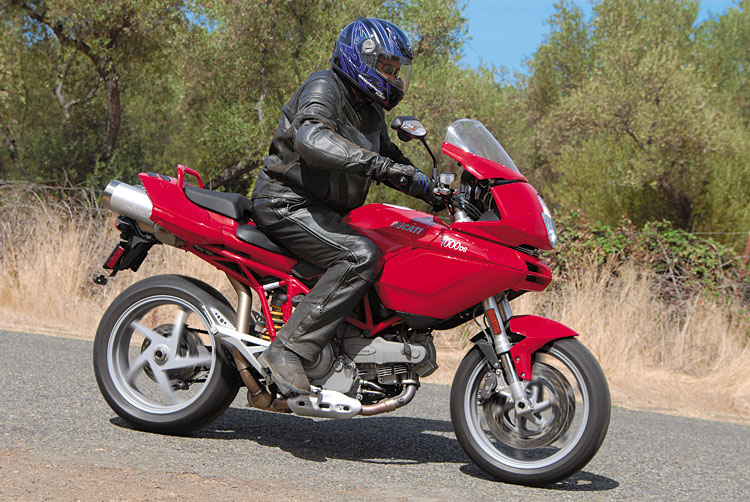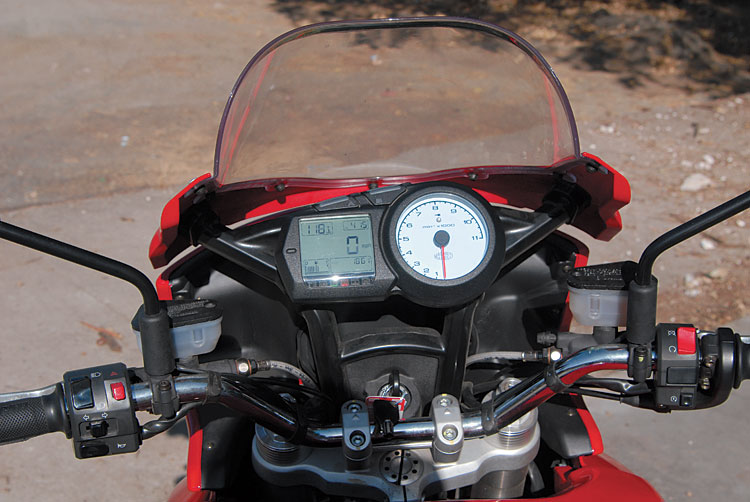Ducati Multistrada 1000DS

If you want to stand out in a crowd, Ducati certainly has the answer. That's my first thought as I ride into a parking lot full of big, bad chromo-cruisers on a bright red Ducati Multistrada. The Duc's avant-garde bodywork and trellis frame give it the look of something that might have fallen off a passing spacecraft, while the retro-Wurlitzer styling of the two-wheeled juggernauts on display is as earthbound as a '59 Caddy.
The heavy-metal brigade is heading north from Topaz, California, for Reno's Street Vibrations as I'm riding south into Toiyabe National Forest. But I shouldn't have been riding the Multistrada at all. Ducati North America had arranged a sport-touring ST3 for me to collect from Southern California Motorsports in Brea, but in the meantime, the ST3 had been sold - the customer comes first, of course. I certainly wasn't disappointed with the Multistrada as a second choice: I'd previously spent a delightful weekend with a tastefully accessorized 1000DS from Ducati's North American HQ in Cupertino, California, and was greatly impressed by its agility and thrust.
The 2006 Multistrada 1000DS is the celebrated marriage of Ducati's outstanding dual-spark 1000cc air-cooled, two-valve L-twin Desmo engine and cycle parts designed for greater ground clearance than the company's sportbike range. The result is a go-almost-anywhere motorcycle that, like Triumph's Tiger, becomes an ideal sport-touring machine for less than perfect pavement, while its upright riding position allows comfortable all-day riding. Certainly the specification shows little compromise from sportbike practice: the 43mm inverted Marzocchi front fork has a sportbike 24 degrees of rake, and the wheel, tire and brake specs all say sportbike too.
What it's not, however, is a dual-sport machine, in spite of the good ground clearance and tall stance. Neither the sport-firm suspension (adjustable though it is) nor the sport-wide tires are suited to off-road use. That's not to say you shouldn't take it on a stretch of graded gravel or dirt; just don't expect dirt-bike reflexes.

The Multistrada's packaging, by in-house styling guru Pierre Terblanche, is distinctive, to say the least. From the front, it looks rather like one of Doctor Who's Daleks, and at the rear, its two under-seat mufflers might have been borrowed from a Saturn V rocket. Even stranger is the split fairing, the top half of which turns with the handlebars while the lower portion stays fixed. In practice, this works very well, allowing the windshield to turn with the steering.
Start me up!
My first challenge is to fit my luggage, intended for stowing in the ST3's hard bags, on the Multistrada. The 1000DS is available with factory luggage too, but mine was not so equipped. A set of Cortech soft bags and some duct tape to protect the Duc's bodywork solved the problem.
The Multistrada's seat is a high perch (33.5 inches to the ground), and it requires a committed swing for me to get my leg over, in spite of my 32-inch inseam. Once seated, I can plant both feet and the high stance offers excellent vision. SoCal Motorsports can shorten the 'strada's suspension to suit more vertically challenged riders, and a lowered example aimed at female riders sits in their Desmo Femminile showroom.

The Marelli fuel injection requires no adjustment, so as soon as I'm onboard, we're ready to go. Thumbing the start button gets the engine turning over - and turning, whether you release the button or not. At first I wondered if the button had stuck, but it's just the computer thinking it knows better than I how to start the engine. Which made me wonder, in the event of an engine fault or running out of gas, if the starter would keep turning until the battery was flat - but I'm sure the system has built-in safeguards. In any case, the Mulitistrada usually starts immediately (though a little reluctantly on cold mornings).
With the idling L-twin chattering away beneath me, I pull in the finger-light clutch and select first, which simultaneously stifles the rattle from the dry clutch. A whiff of throttle and we glide onto the street.
Maybe it's something in the water (or the wine), but Italians seem almost incapable of making a bad bike, and the Multistrada is no exception. It's uncanny how quickly the Duc becomes almost a biomechanical extension of my will. Everything works the way it should: quick, neutral steering, smooth, powerful brakes, and suspension that is completely unobtrusive, simply isolating me from minor surface imperfections.

The engine in particular is a delight - and though it needs to hit 3,000rpm or more to avoid power-stroke shuddering, thrust builds remarkably evenly through the rev range to a level that feels like more than its rated 92hp at the crank. For 2007, Ducati has increased engine size to 1078cc with horsepower up to 95, and I hope the extra cubes don't upset the motor's free-revving character. Especially impressive is how smooth the motor is on the overrun, emphasizing the excellent primary balance inherent in the L-twin design.
Riding north from Boulder City to Ely, Nevada, I gain an appreciation for the Multistrada's road manners: in spite of some seriously blustery winds, stability is never seriously perturbed and I'm able to maintain a respectably fast pace. The engine feels like it would run forever at around 5,000rpm, equating to 80mph or so, and still have serious power for passing. This works best by dropping a couple of gears and using the higher end of the powerband.
One slightly disconcerting aspect of my ride was fuel range, or rather, what exactly my range was. The digital dash display included a fuel range readout - very handy - except that when I got to within an indicated 60 miles of running out of fuel, the screen went blank and the low fuel warning light came on. Just when I really needed to know how far I had to go, the information disappeared. OK, so I could have estimated my true range from the last reading and my overall fuel economy - but with an unknown motorcycle in the Nevada desert? No, and I didn't want to chance it either.

Although the 'strada has a 5-gallon tank - good, you'd think, for at least 160 miles - the warning light/blank readout thing happened at around 110 miles. The first time, I was 20-plus miles from Ely, and though I made it into town OK, it was an unnerving experience. Ducati claims a 1.7-gallon reserve, but without running the bike to completely empty, there's no accurate way of knowing how far you can safely ride. In Nevada this is a challenge: Tonopah to Ely is 180 miles with no gas stops between!
One other minor problem arose: under duress from a combination of the weight of my soft luggage and the heat from the mufflers, the molded rear bodywork under the dual-seat started to deform after a couple of days riding, to the point where the plastic was scorched by the mufflers' heat. Few modern motorcycles except cruisers make allowances for throw-over bags in spite of their popularity for intermittent touring: form seems to have ousted function here.
These minor niggles aside, and as long as you can come to terms with its styling, the Multistrada is one of the most versatile, comfortable, practical, and downright fun motorcycles for sale. You'll stand out in a crowd, too. It has great performance and handling, and it prowls any paved road with aplomb. I particularly like the tall-in-the-saddle riding stance which inspires great confidence in the twisties.
A couple of other things impressed me. My Multistrada was brand new when I collected it, so I did take it easy for the first few miles; but the engine soon settled in and never showed any fussiness, even though I started my journey at sea level in LA and spent some days at over 8,000ft. The Ducati's freshness also required I get its 600-mile service carried out while on my tour route. The people at Salt Lake Motorsports were kind enough to do this while I looked in at Miller Motorsports Park near Bonneville. I was expecting the Ducati's valves might need inspection, but servicing intervals on the Desmo engine have been extended over the years. So all that was needed was an oil change and a general check-over.
I'm sometimes pleased to hand back a press bike, but I could have happily ridden the 1,500-odd miles home on the Multistrada. It's definitely on my shortlist of candidates to replace my aging Triumph Sprint.
And so, if life is a highway, as rocker Tom Cochrane would like us to believe, then Ducati's Multistrada is an adrenaline, testosterone and endorphin rush that will put a smile on your face every time you take it on the street.
Second opinion
Text: Trixi Keckeis-Hiller
'Okay,' I thought, when I picked up the Multistrada for a test ride, 'you can't judge a book by its cover.' Like many of Pierre Terblanche's designs for the Italian manufacturer, this one also has a number of futuristic qualities that leave some riders drooling and others, like me, scratching their heads. But once under way, the first thing that grabbed me was the traditional heart of the Multistrada, the 90-degree L-Twin. It still loves to beat hard in lower gears and now, thanks to some internal improvements, runs as strongly at highway speeds, exhibiting a lively, prompt response through all the gears. Chassis-wise, everything gets a thumbs-up as well. Suspension damping, the gearbox, and brakes have all benefited from improvements over last year's model.
Though irritating at first, I soon got used to the headlight/fairing unit that remains fixed while cornering. What did tend to bug me was the routing of the exhaust pipes beneath the pillion. Despite being covered in protective material, they really heat up the rear seat. I'm just glad I don't spend any time back there.
Keeping in mind that looks are subjective, there's no doubt that this is one fine motorcycle and an excellent choice for those torn between a road bike, dual-sport, or supermotard. The Multistrada is, quite simply, all three bikes wrapped up in one. It offers the maneuverability associated with broad handlebars, a comfortable, upright seating position, and the ability to maintain a sporty pace and hard cornering. Even with the extra weight of passengers and/or luggage, no funny handling traits present themselves. I'll admit to not being blown away by the styling at first, but at the end of the day, I happened to see my reflection in a street-side window and it looked pretty good. I guess when a bike rides this nicely that its looks are just bound to grow on you.
Technical Specs
2006 Ducati Multistrada 1000DS
+ great engine, excellent handling, character
- flimsy bodywork, love-it-or-hate-it styling
Distributor Ducati North America
MSRP $ 11,999 (2007, 1100cc model)
Engine L-twin, 2 valve Desmodromic
Displacement 992cc
Bore x Stroke 94 x 71.5mm
Carburetion Marelli electronicfuel Injection, 45mm throttle bodies
Power 92hp @ 8,000rpm
Cooling air
Ignition computer-controlled digital with electronic advance
Transmission six-speed
Frame tubular steel trellis, single-sided swingarm
Front Suspension Showa 43mm inverted fork, fully adjustable, 6.5in travel
Rear Suspension Showa monoshock, fully adjustable, 5.6in travel
Rake/Trail 24°/ N/A
Brakes Front/Rear two 320mm discs, 4 piston calipers / one 245mm disc 2 piston caliper.
Tires Front/Rear 120/70 ZR 17, 180/55 ZR 17
Dry Weight 432lbs (196kg)
Wheelbase 57.6in (1462mm)
Seat Height 33.5in (850mm)
Fuel Capacity 5.3gal (20l)
Fuel Consumption n/a
Color red, black